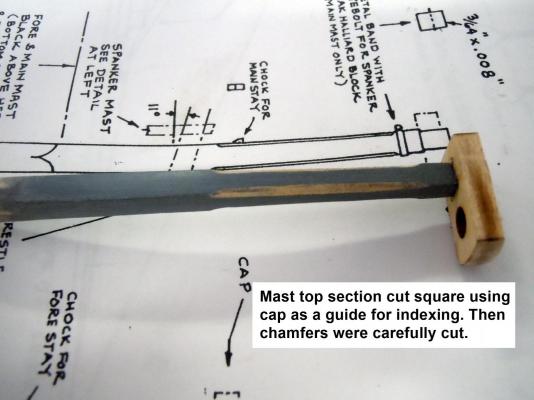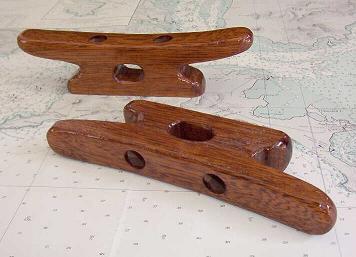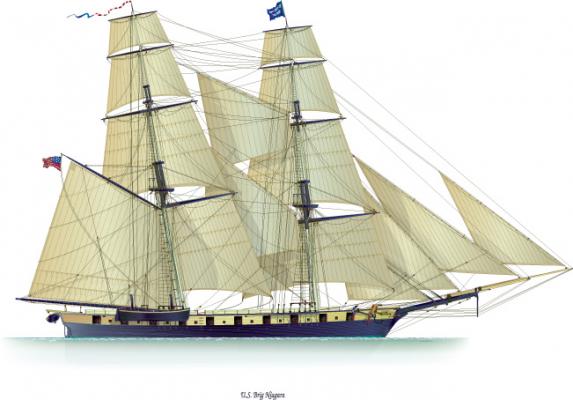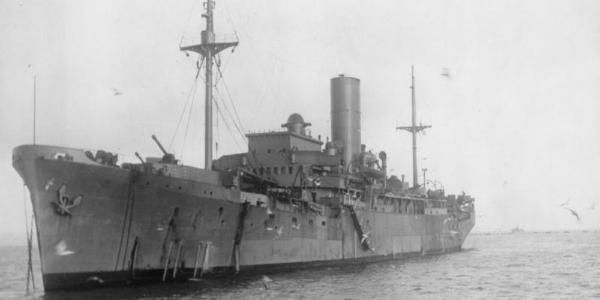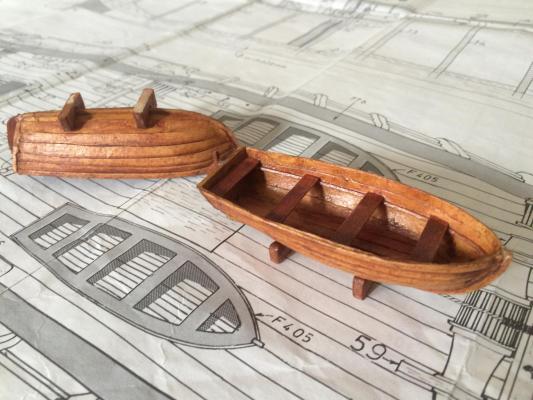
JerseyCity Frankie
Members-
Posts
1,338 -
Joined
-
Last visited
Content Type
Profiles
Forums
Gallery
Events
Everything posted by JerseyCity Frankie
-
Here is the photo in question and to my surprise I see Model Shipways is calling that Cleat a Chock. I wonder why? Now I see where the confusion is coming from. That IS a Mast Cleat. It is to keep the after portion of the Main Stay from slipping down on top of the shroud gang on the Bolsters while preserving the line of the lead down to the bow. its literally just a wedge shaped piece of wood nailed onto the back of the mast. Its blunt end acts as a little shelf that prevents the loop of the stay from sliding down.
-
Not sure what you mean by "chocks"? Do you mean Cleats? Cleats being the single-piece two horned object used to belay a line. Its fairly easy to make cleats with thin stock and a needle file. The actual Niagara is unlikely to have used metal cleats, in my opinion. As to the sheaves in the spars, I know some very very detail-oriented modelers have put actual sheaves into scale masts but most of us simply drill a hole through and reave the rigging through the hole. Or if you want to go into more detail you can widen the edge of the drilled hole with the tip of an ex-acto into a rectangular opening, paint the inside black. The top should be parallel with the surface of the water ( or is it the deck below? anyone?) NOT square to the mast, which is raked. I found this schematic showing the rake of the masts and the attitude of the tops to the masts.
-
Armies fight on their stomachs but frequently there must be a beverage. The Royal Navy understood the morale benefits of having decent beer available in quantity in the Pacific theater and took steps to assure it would be available by ordering the construction of ten ships that could each brew 250 barrels of beer a week. These ships were built at the insistence of Winston Churchill himself and were not only to include breweries, but also cinemas, dance halls and other amenities, which is why they then became known as amenity ships. In the event, only two were completed by VJ Day and of those only one, the HMS Menestheus was able to get into the theater in time to start brewing beer on station. One wonders if they had special signal flags. I hope they did. Here is the article that inspired this post: http://vinepair.com/wine-blog/wwii-british-floating-brewery/?utm_campaign=atlas&utm_source=facebook&utm_medium=social
-
need opinions on furled sails
JerseyCity Frankie replied to keelhauled's topic in Masting, rigging and sails
I like this video. It starts with a sail that has been Clewed Up and then we see the sailors clime onto the yard and watch as they take all the steps to manipulate the sail into the much smaller and neater Furl. Its still a bit difficult to see what is going on since all parts of the sail look alike. The lead blocks for the Clews and the Buntlines , the ones attached to the yard itself, determine where a lot of the canvas will wind up at the end since it is at these points that the foot of the sail is brought to the yard. Notice that most of the canvas starts out hanging between the two Buntline lead blocks on the yard and the Clews of the sail are out of sight on the aft side of the sail and masked from view untill the midpoint of the video when they are brought up on top of everything else on the yard. Not easy to see is that the crew is tucking much of the folded canvas under a "skin" of canvas- the part that will be visible on the outside of the furl. EVERYTHING but the Clews gets tucked under this skin which is then made as nearly as tight to a drum as a single membrane covering everything else. The skin is more areodynamic and will also shed water better. -
need opinions on furled sails
JerseyCity Frankie replied to keelhauled's topic in Masting, rigging and sails
I think its possible to err to far on the side of "literal" in ship model building. The "Effect" you want is to have a model representationof the full size sail. Even though you use only 50% of the fabric of the sail, you are being too literal in my opinion, there is too much bulk. The visual effect of a furled sail, when it is carefully stowed in a nice furl by the crew, is of a much smoother and more tapered white taco-like shape sitting on the yard. The tapered ends of the bundle of sail are only a couple inches higher than the surface of the yard. You are trying to literally furl the sail, by folding it tightly. But try as you may, the fabric you use will never fold up as tightly IN SCALE as on the real ship, your full scale fabric will not bend sharply or lie flat enough. My advice is to discard the literal and embrace artifice. Make your sail out of a single fold of fabric and try to press the ends down tighter then the middle. On my HMS Victory I made the furled sails out of paper while the rest of the sails, which were set, were of fabric. The paper was much easier to mold into the shapes I needed- I soaked the paper in white glue and glommed them into shape and when dry I painted the paper to match the color of the sails. -
I tried diluting PVA and varius other acrylic products as a means of knocking down the fuzz on lines. I would mix the concoction then saturate a bit of cotton rag with it and wipe the rag over the line- in one direction while pinching the rag in a way that would force the liquid into and over the line- and repeat that two or three times. When the line dried the same fuzz was now stiffened.
- 2 replies
-
- Waxing line
- dilute PVA
-
(and 1 more)
Tagged with:
-
Has it really been five years? Congratulations! This is one of my favorite build logs to follow. You appear to think you are not as good a builder as some people? While there will always be someone somewhere that can do things better than any of us individually, I still have to point out that the modelers who work in a large scale and actually build an honest Plank on Frame Ship of the Line are few and far between. I never have.
-
I'm restoring a model that had the parel in place. Sadly the guy had chosen brown beads that were translucent. With the light from behind the beads look all wrong as they appear to glow with an inner light if the sun hits them right. Get opaque beads!
-
As above, the important thing is to get the centerline correct on the extreme ends, the Bow and the Stern. Connect the dots via the use of a flexible ruler or piece of cardboard pressed down onto and following the contours of the hull- draw your line. You will wind up having to re-draw any pencil lines you put onto the hull over and over again as you work on the hull and remove material. Be careful to not remove your crucial Bow and Stern landmarks as you proceed. Cutting a piece of paper the exact distance between two points on the hull, then folding the piece of paper in half gives you the center point between two locations quicker than using a calculator.
-
In the event I wound up making some fairly generic boats, scaling and shaping them to the dumb drawing I had on the Billings Boats plan. I made them on a dummy wooden form, planking over the form with card stock, which I then painted after detailing. The keels are wood but everything else is paper. These are in a color that matches the existing trim color used by the original model builder.
-
Concerning the store bought Belaying Pins, I regard them as one of the great shames of the hobby. Manufacturers turn out decent metal pins but the wood ones they offer are a scandal and they do more to ruin good models than nearly any other off-the-shelf fixture, in my opinion. The engineering involved in turning out thousands of consistent wooden pins is too difficult to do economically I suppose- getting your industrial lathe to work at that level of tolerance in the wooden medium must be impossible so the best they can do is turn out these cartoonish wooden bulbs and call them Pins. Then the problems cascade from there as model builders try to reconcile these fat pins with their accurate plans, plans which show pin rails of accurate length and an accurate number of holes for pins. Now when these fat pins are jammed in there their holes have to be bored out larger to fit them and the spacing between the holes has to be tighter too in order to get them to fit on the rail, leaving not enough room between them to allow for the lines to be properly belayed and ruining the realism of the model. I have always made pins out of piano wire or stretched plastic sprue. This is not an option for the purist who can only envision the use of wood overall on their models. But I always rig my models and my accurately scaled pins vanish under the three crossing turns of the belayed lines leaving only their heads visible.
-
I also have a hard time wrapping my head around the idea that for most of the decades of square rigged sailing there were no documented Jackstays on the yards. Which I view as an impossibility but there it is, no documentation for jackstays until very late in the game. Its unscientific and unsupportable to go ahead with gut feelings when researching ship models. We should certainly stick to only the things that the physical record bears out. But I still can not imagine a gangway of any sort on any ship of size without a nod to safety in the form of a rope or wooden handrail to assist climbing up and down in heavy seas. There is a huge grey area you can step into though in which you could imagine scenarios where hand rails or hand ropes were put up and taken down over the life of the vessel, so unremarkable and mundane that their disposition or lack there of was never mentioned in a surviving record. But I KNOW you can't really use that method of thinking as a basis for argument.
-
This is a completely legitimate and necessary fixture for a vessel of this size. If you are below decks it is crampt and dark and airless. The box formed by the skylight set into the space above your head allows for headroom under it, a sparse commodity. It also allows light and air into the otherwise completely dark compartment- you can't burn oil lamps 24/7 at sea, it is dangerous and wasteful. The top of the skylight on a small ship like this is too valuable a piece of real estate to give over entirely to glazed panels that can not be trod upon, the sailors need to stand on it in order to furl the Main, so the glazing is at the sides- which incidentally could be swung open to allow ventilation. Larger ships have more glazing and their deck furniture incorporates seating and completely galzed skylights with a triangular pitch.
-
People will write in and ask for a clarification on the date and the type of ship you are talking about. Quite rightly. But in general I cant imagine a ship without a handrail of some kind on any of the stairs aboard, unless they are ladders. I DO see a great deal of stairs on models, those connecting the poop deck and forecastle head with the rest of the deck for instance, with very steep treacherous stairs and no handrail provision of any sort and this never strikes me as plausible. Ships pitch and roll too much for a lack of a handhold in a place like that. There would be too many broken bones otherwise.
-
You put the hoops on ahead of time, long before you will need them, because at the end of the build the tops of the masts- the trestle trees and cross trees- will prevent the hoops from simply being slipped over the top of the naked mast. Its a LOT easier to slip the hoops on when the spar is a simple cylinder compared to having to individually form eight or twelve hoops on a completed glued in place mast when the built up tops will prevent you from slipping hoops on.
-
I'm a little worried about the cumulative stresses too. Initially I though maybe there would be lead blocks on the deck under the rail so the lines wold lead down to those blocks then up to the pins and the force would be pulling down on the rail not lifting it off. But thats a lot of blocks. A lot of the lines you list don't cause too much alarm but ANY hailyard or the Mainsail and Topsail Clewlines ARE going to have heavy loads on them and there is no way, in my opinion, they could be made on that rail, even run through sheaves in the stanchions. I would put the Main Clews on the Jeer Bits if it was me.
-
Its a very nice Ship in a Bottle! Also I love hearing from a model builder in Ankara-Türkiye! Also I will point you in the direction of this website dedicated to Ships in Bottles: http://www.bottledshipbuilder.com/ which has a lot of resources for ship in bottle builders much like this website Model Ship World.
-
On a side note I will ad that line is always coiled clockwise on ships, unless the line is shroud laid which it never is. Its a very small detail but on the other hand there is no ambiguity about the direction you coil a line, it IS always coiled clockwise on EVERY tall ship and it is something I scan for when I am looking at a model.
-
The Course Yard Lifts do NOT go through the shrouds, they pass across the front of the Topmast Shrouds. It looks counterintuitive though and MANY ship modelers lead them on the most direct path, which takes them THROUGH the Topmast Shrouds. Many two dimensional ship model diagrams appear to show them led this way. This is wrong. But you can find examples of this incorrect lead in even the best ship model collections in Museums. Its a very common misunderstanding. As you point out, when the yards are braced the lifts would foul the shrouds were they led between them. Also when the yard tackle is employed the lifts take on more significance as they come under more strain hoisting in and out boats and cannon ect. Also the crew needs to climb the Topmast Shrouds unimpeded. And the Course Yard itself needs to be adjusted fore and aft via the Truss and thus the lifts can not be constrained as they would be if run through the shrouds. But even the correct lead is not without its problems as the leward Lift will always chafe against a shroud. I have seen people work around this chaffing by rigging the lift blocks at the masthead on pennants which are long enough to get the running part of the tackle outboard of the shroud. But this causes problems with the lead of the fall of the tackle. Another solution I often see used it to put the Lift Span forward of the Topmast on the Lower Mast Cap, which makes a great deal of sense but which I don't see a lot of documentation on.
-
As to the question of plank thickness on ships boats I have a strong opinion that most modelers make their planks way too thick and out of scale, and this results in boats that look too chunky and toy-like. The problem is that to achieve an accurate thickness the wood has to be ridiculously thin, a thickness that makes the wood as fragile as could be, a thickness that is impossible in some species of wood. So I always use paper. At scales under 1/48 even the paper is too thick, but its much closer to actual scale thickness than any wood. Purists will tell you that there is no place for paper ( or anything other than brass, apparently) on a wood ship model but I take the point of view that the Ends Justify the Means in the world of art, and I will use any material that gives me the result that I am after. Using wood because "that is what you are supposed to use" prevents achieving a realistic result in some circumstances and I am quick to discard the use of wood when it comes to realism.
-
Mike you do have a Post Script on your profile which appears at the bottom of your post and it DOES say " Current Builds: US Brig Niagara - Model Shipways - First Build" But it is NOT a hot link. Meaning, when you click on it, it does NOT take the reader to your build log. It is likely you did not follow the instructions properly on "adding a build log" and you should go back and re do it.AND THEN TEST IT YOURSELF to make sure it works. As mentioned above, having a build log linked to everything you post is the best way to drive traffic to your build logs. Go here and follow the instructions precisely: http://modelshipworld.com/index.php/topic/760-how-to-add-a-build-log-link-to-your-signature/
-
I use "artist" acrylics like Golden and Liquitex. I have had plenty of experience with cheep acrylics too. When you spend the extra money on the "artist" acrylics what you are paying for is the better color quality that comes with more expensive pigments, like the Cadmiums. But you don't really need such intense colors on accurate ship models since the actual ships would not have had such intense colors anyway. The bad aspects of cheap paint is that the consistency is poor and often not the same from color to color, and often they are gummy. But this is not a deal breaker since you must ad water to them in any case to get them to flow correctly. Up until recently I would have said that acrylics formulated for modelers and sold in tiny bottles was a waste. But recently when I mail ordered a bunch of stuff from Model Expo they included in my delivery a tiny 17ML bottle of Vellejo Model Color, black. And I have to say I am a fan, this stuff is great and very convenient in its squeeze bottle packaging. Long story short: You can use cheap acrylic paint but it may be a bit more work. Also: Never use cadmium or cobalt pigmented paint in an airbrush in a room that is not ventilated and wear a good mask.
-
A Quarter Lift or a Topping Lift is used to hold the boom up off the deck when the sail is not drawing. Without such lines the boom would rest on the deck when the ship wasn't underway. These lines run from the mid or after part of the boom up to the area around the underside of the Crosstrees or Trestle trees on the same mast the boom is on. I think what you are describing are Topmast Shrouds. Topmast Shrouds on a schooner run from the upper sides of the ends of the Cross Trees (not the Trestle Trees) all the way to a collar near the top of the Topmast, they do not run to the deck. And they would then tarred, likely served and tarred. If your lines ARE on the Trestle Trees ( which run for and aft, not port and starboard) and run up from there to the topmast head, then I am not at all sure what they are. I think I can say with certainty that no shroud ever ran from any trestle tree.
-
Question about Spinnakers & Stunsails
JerseyCity Frankie replied to strangway03's topic in Masting, rigging and sails
The short answer is that no, this is not a practical sail for a ship like the one you mention. Nor could it be termed a spinnaker or a stunsail. You are describing something like a pair of banners. -
I am guessing they would be tarred if there was tackle on them near the masthead? and I will add they likely had baggywrinkle on them too. It may be that the more proper term for them is going to be Quarter Lifts?
About us
Modelshipworld - Advancing Ship Modeling through Research
SSL Secured
Your security is important for us so this Website is SSL-Secured
NRG Mailing Address
Nautical Research Guild
237 South Lincoln Street
Westmont IL, 60559-1917
Model Ship World ® and the MSW logo are Registered Trademarks, and belong to the Nautical Research Guild (United States Patent and Trademark Office: No. 6,929,264 & No. 6,929,274, registered Dec. 20, 2022)
Helpful Links
About the NRG
If you enjoy building ship models that are historically accurate as well as beautiful, then The Nautical Research Guild (NRG) is just right for you.
The Guild is a non-profit educational organization whose mission is to “Advance Ship Modeling Through Research”. We provide support to our members in their efforts to raise the quality of their model ships.
The Nautical Research Guild has published our world-renowned quarterly magazine, The Nautical Research Journal, since 1955. The pages of the Journal are full of articles by accomplished ship modelers who show you how they create those exquisite details on their models, and by maritime historians who show you the correct details to build. The Journal is available in both print and digital editions. Go to the NRG web site (www.thenrg.org) to download a complimentary digital copy of the Journal. The NRG also publishes plan sets, books and compilations of back issues of the Journal and the former Ships in Scale and Model Ship Builder magazines.

